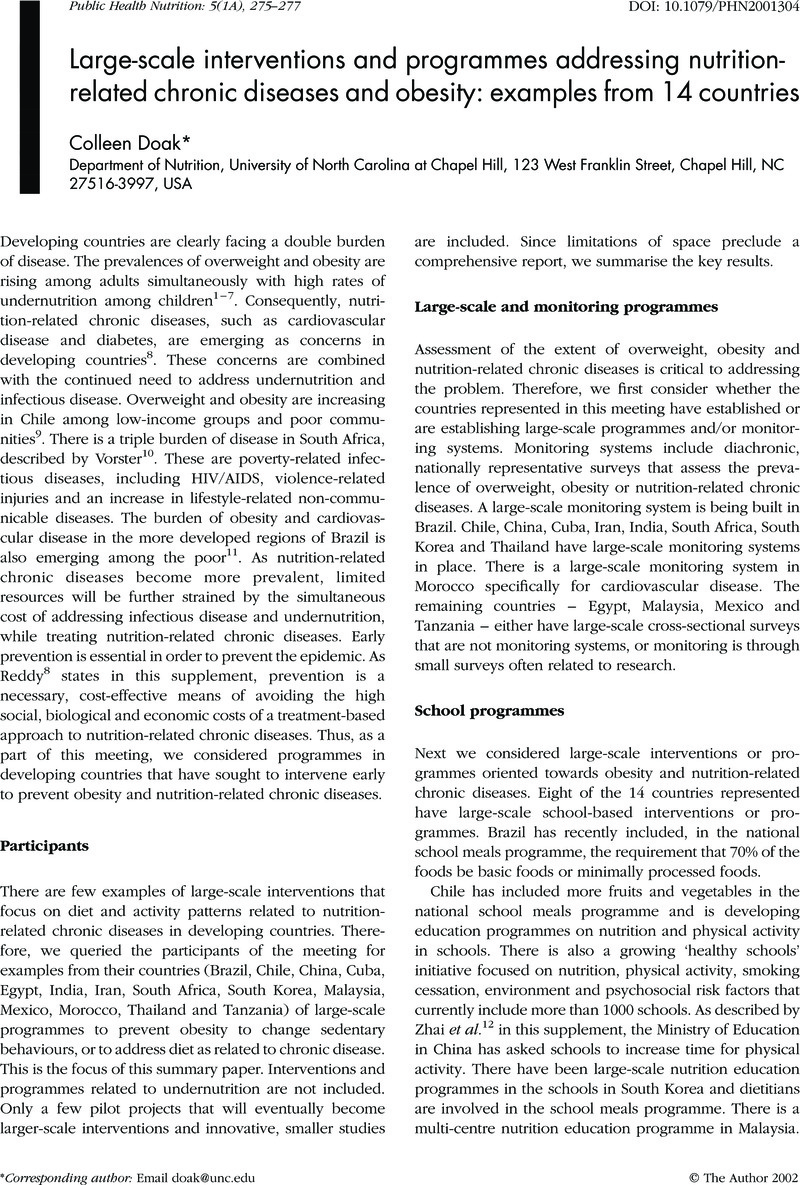Crossref Citations
This article has been cited by the following publications. This list is generated based on data provided by Crossref.
2002.
An overview on the nutrition transition and its health implications: the Bellagio meeting.
Public Health Nutrition,
Vol. 5,
Issue. 1a,
p.
93.
Caballero, Benjamin
and
Popkin, Barry M.
2002.
The Nutrition Transition.
p.
241.
Haddad, Lawrence
2003.
Redirecting the Diet Transition: What Can Food Policy Do?.
Development Policy Review,
Vol. 21,
Issue. 5-6,
p.
599.
Singh, R.
Shaw, J.
and
Zimmet, P.
2004.
Epidemiology of childhood type 2 diabetes in the developing world.
Pediatric Diabetes,
Vol. 5,
Issue. 3,
p.
154.
Glass, Thomas A.
and
McAtee, Matthew J.
2006.
Behavioral science at the crossroads in public health: Extending horizons, envisioning the future.
Social Science & Medicine,
Vol. 62,
Issue. 7,
p.
1650.
2007.
Nutrition in Public Health.
p.
159.
Mangunkusumo, Resiti T
Brug, Johannes
de Koning, Harry J
van der Lei, Johan
and
Raat, Hein
2007.
School-based Internet-tailored fruit and vegetable education combined with brief counselling increases children's awareness of intake levels.
Public Health Nutrition,
Vol. 10,
Issue. 3,
p.
273.
Delisle, Hélène F.
2008.
Poverty.
Annals of the New York Academy of Sciences,
Vol. 1136,
Issue. 1,
p.
172.
Kamradt-Scott, Adam
2009.
Disease outbreaks and health governance in the Asia-Pacific: Australia's role in the region.
Australian Journal of International Affairs,
Vol. 63,
Issue. 4,
p.
550.
Monteiro, Carlos A.
Hawkes, Corinna
and
Caballero, Benjamin
2010.
Obesity Prevention.
p.
463.
Moore, Spencer
Hall, Justin N.
Harper, Sam
and
Lynch, John W.
2010.
Global and National Socioeconomic Disparities in Obesity, Overweight, and Underweight Status.
Journal of Obesity,
Vol. 2010,
Issue. ,
p.
1.
Irizarry, Laura M.
and
Rivera, Juan A.
2010.
Preventing Childhood Obesity.
p.
147.
Galal, Osman M.
and
Harrison, Gail G.
2010.
Preventive Nutrition.
p.
757.
Moadab, Mohammad Hasan
Kelishadi, Roya
Hashemipour, Mahin
Amini, Masoud
and
Poursafa, Parinaz
2010.
The prevalence of impaired fasting glucose and type 2 diabetes in a population-based sample of overweight/obese children in the Middle East.
Pediatric Diabetes,
Vol. 11,
Issue. 2,
p.
101.
Thow, A. M.
Snowdon, W.
Schultz, J. T.
Leeder, S.
Vivili, P.
and
Swinburn, B. A.
2011.
The role of policy in improving diets: experiences from the Pacific Obesity Prevention in Communities food policy project.
Obesity Reviews,
Vol. 12,
Issue. s2,
p.
68.
Alderman, H.
and
Bundy, D.
2012.
School Feeding Programs and Development: Are We Framing the Question Correctly?.
The World Bank Research Observer,
Vol. 27,
Issue. 2,
p.
204.
Ruel, Marie T
and
Alderman, Harold
2013.
Nutrition-sensitive interventions and programmes: how can they help to accelerate progress in improving maternal and child nutrition?.
The Lancet,
Vol. 382,
Issue. 9891,
p.
536.
Yu, Jiantuo
2013.
Multidimensional Poverty in China: Findings Based on the CHNS.
Social Indicators Research,
Vol. 112,
Issue. 2,
p.
315.
Ashe, Leah M
and
Sonnino, Roberta
2013.
At the crossroads: new paradigms of food security, public health nutrition and school food.
Public Health Nutrition,
Vol. 16,
Issue. 6,
p.
1020.
Tsui, E.K.
Wurwarg, J.
Poppendieck, J.
Deutsch, J.
and
Freudenberg, N.
2015.
Institutional food as a lever for improving health in cities: the case of New York City.
Public Health,
Vol. 129,
Issue. 4,
p.
303.



